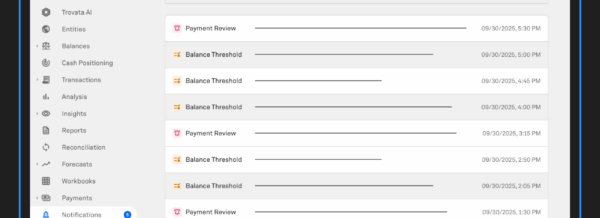Treasurers and treasury teams are no strangers to pain points. The causes of friction in treasury operations can be wide ranging, from overreliance on slow, manual workflows, incomplete or inaccurate financial data, poor banking connectivity, or limitations in forecasting and data analysis capabilities.
These problems can be frequent and obvious. But finding the solution to them isn’t always as clear. While it’s simple to identify the areas that need improvement, it can seem almost impossible to sift through the jargon and conflicting opinions on exactly what types of software or technology can help solve them.
And if you don’t know what specific technology you need to solve your problems, then finding the right software platforms to compare can feel like trying to use Google in Mandarin.
So in this article we’re going to be flipping things and talking through some important considerations for evaluating treasury software. From there we’ll cover why traditional solutions still create challenges and consider some modern treasury tech alternatives that will transform your workflow.
What You Need: Accurate, Real-Time Banking Data
There’s nothing of more fundamental importance to treasury than access to current, accurate banking data. But something as simple as being able to access current cash balances across a company can be a surprisingly difficult technical challenge.
The broad solution is enhanced bank connectivity. Essentially, that means finding ways to transfer data from a company’s banking portals into a single platform where all the information can be viewed in one place. Many different technologies have been created to facilitate this, but with varying levels of success.
Without clean, accurate data, treasurers are limited in their strategic capabilities. There’s little value in cash forecasts if there are concerns over the accuracy over the current data, and conducting data analysis to identify trends in the data can be meaningless if there’s information missing from the data set.
The Traditional Approach to Bank Connections
The traditional approach to bank connectivity has been through the use of direct connections. That is, a specific data link between a bank and a third party software platform. This is a direct connection that is facilitated on an individual basis (known as Host to Host or H2H) or through an existing network such as Swift.
These technologies pioneered banking connectivity, allowing files to be sent digitally from physical banks to physical corporate servers. However, there are inherent limitations with this method. For example, because the files and platforms are so rigid, auto payment matching rates can be as low as 20%. That’s 80% of transactions having to be manually reconciled.
This file based approach also means relying on the bank to send the file in order to update the software platform. They may only do this at sporadic intervals, leading to banking information that is constantly out of date. Not only that, but there is a limit as to how much data can be transferred in these files.
These limitations leave many treasurers frustrated. Theoretically they may have a technology solution that purports to provide multi-bank connectivity, but the reality is data that can’t be relied on.
The Modern Solution – APIs
APIs provide multi-bank bank connectivity that’s designed to meet the needs of modern treasury teams.
An API is essentially a language that allows two systems to communicate; in this instance a company’s banking portal and the treasury software. Because it’s a language, rather than a link designed to send or receive a narrow range of specific data, the amount of data that can be transferred is practically unlimited.

And because the connection is always on, the data is available with 100% accuracy, in real time.
The standardized nature of APIs also means that new connections can go live in days, even hours, as opposed to traditional direct connections that can take months to set up. It’s multi-bank connectivity that has been built on modern, cloud-native architecture.
The downside? Banks need to create an API link so that their data can ‘speak the language.’ The vast majority of banks already have an API, but some smaller regional banks may still be in the process of development.
What You Need: A Scalable and Flexible Solution
Getting the right tech solution in place for today’s business needs is only half the battle, because a company is never static. Banking solutions change, companies expand into different countries, create new business units, and undertake joint ventures.
At the same time, there is hopefully a steady rate of growing revenue and profit. Treasury solutions need to be able to scale with the business. There’s no use having the perfect tech setup, if the whole thing requires reengineering in 12 months’ time to adjust for growth and change.
This same theme extends to new features, security updates and upgrades. Modern treasurers need a platform that stays current to the demands of the industry and the role, with the ability to continuously improve its capabilities.
The Traditional Approach to Data Infrastructure
Traditional treasury platforms are built on fixed architecture. In many cases this even means physical servers on premises, even with ‘cloud-based’ functionality. When new banking arrangements are set up or there’s expansion into new territories, this creates the need for re-engineering of the software.
The process can take months, comes at a hefty cost and requires system shutdowns and extensive testing before it can go live. The same is true for system upgrades, with the average legacy TMS pushing out updates just once or twice per year. This slows the pace of innovation with practical limitations on how quickly new features or upgrades can be added.
The Modern Solution – Cloud-Native Tech
Cloud-native tech is effectively infinitely scalable. Any new data source (such as a new bank or a new set of accounts with an existing bank) simply requires connection of the API. Rather than taking weeks of months, the update can be pushed live in a matter of hours.
This allows treasury data to scale immediately in line with business operations, providing instant access to every piece of banking data without the need for costly upgrades or system downtime.
The modular approach of a cloud-native solution also means that upgrades and new features can be pushed quickly, efficiently and without a system shutdown. Rather than updating once or twice per year, cloud-native software can update every couple of weeks. This means a faster rollout of new features, providing users with a platform that is continuously improving.
What You Need: Enhanced Forecasting and Analytics
Treasury has come a long way. Managing liquidity and the current cash position isn’t where the job ends, with an increasing need for strategic advisory. To do this effectively treasurers need access to enhanced analytics and forecasting capabilities.
This allows the creation of baseline forecasts, but also helps consider various strategic decisions through the use of scenario planning tools. Not only can this help improve growth prospects, but also risk management practices.
The Traditional Approach to Data Analysis
Traditionally, many treasurers operate from Enterprise Resource Planning (ERP) software. However, these systems are generally lacking when it comes to forecasting capabilities. It’s one of the main reasons treasurers using an ERP begin to research alternative options. This generally leads to forecasting being completed in a totally separate solution, such as the use of the spreadsheets.
While spreadsheets are highly customizable, they are very susceptible to human error, require a substantial amount of manual input and become unwieldy or even unusable with large datasets.
The Modern Solution – Automated Reporting and Forecasting
Forecasting and analytics tools are at the heart of dedicated treasury software. These platforms have been built for the needs of modern treasurers, with advanced capabilities for forecasting, scenario planning, and more.

The combination of real time data via APIs also means that these forecasts can be dynamically updated based on actual information, rather than relying on manual updates like spreadsheets.
Many offerings also layer on AI and machine learning technology, to allow analysts to quickly create scenarios, identify trends or highlight anomalies in these forecasts or historical data.
Pitfalls to Avoid
So to summarize, the fundamental features that treasurers should look for in modern treasury tech are:
- Multi-bank connectivity facilitating real time, accurate, and complete banking data
- Scalable and flexible architecture that can update and grow quickly and efficiently
- Comprehensive forecasting and analytics capabilities
But it’s not always easy to compare the feature set of one provider to another. With that in mind, here are some pitfalls to avoid when looking for a new software solution.
Cloud-native vs. Cloud-based
According to a 2022 Deloitte treasury survey, 42% of practitioners favor cloud technology when implementing treasury software. However, there is an important note when evaluating cloud software: cloud-native vs cloud-based.
This is a common sleight of hand that can be very easy to miss. Cloud-based solutions have been designed to run on local servers with remote access added later, whereas cloud-native applications have been built specifically for the cloud.
That means cloud-based programs have been built as a single, static piece of software, which is why the implementation and update process is so inefficient.
Cloud-native, API-first solutions like Trovata are built with a modular design. Rather than using a single piece of software, users are interacting with a large number of individual applications which are all connected through APIs. The difference is profound, even if the appearance to the end user remains as a single program.
Recommended: Check out this episode of Fintech Corner as our very own Brett Turner and Joseph Drambarean discuss the tough questions to ask when assessing a cloud-based tech provider.
API confusion
There are still segments of the treasury technology sector not offering API capability, which can often lead to misrepresentation around their value. In other cases, some legacy TMS providers are using bank APIs, but then converting the data from the API into the file based transmission method, with all of the inherent limitations discussed earlier.
It’s important to understand exactly how your prospective provider uses API technology, and whether they are leveraging it on an end-to-end basis. If they aren’t, then the addition of APIs to the tech stack will add little value.
Feature overload
Anyone who’s ever been in the market for new technology of any type knows how easy it is to get distracted by features. How many of us buying a new car have spent hours trying to decide whether the 8 speaker stereo system and LED headlight package is better value than the heated seats and parking assist?
Those features might be interesting, but they won’t make a bad car good to drive. In the same way, additional features won’t somehow make poor treasury software any better at the fundamentals.
When looking for the right solution for your company, be sure to focus on the core improvements that you need. Highlight your biggest pain points, and choose the technology that best solves those problems.
Evaluating Treasury Software: How Trovata Transforms Treasury Operations
Trovata is a modern treasury platform that offers the best of what modern tech has to offer. The API-first, cloud-native software offers treasurers access to 100% accurate, real time data from all banking portals, in one place. All of that without any manual input, meaning no possibility of data entry errors.
API multi-bank connectivity creates a data-rich network that offers deep analytics, sophisticated tagging, and automatic categorization tools, along with a natural language search function and customizable dashboards.

And of course, it’s built around forecasting capabilities which gives treasurers insight into how decisions made now might impact cash positioning and liquidity in the future. Create scenarios and adjust assumptions, and turn treasury into a true strategic partner to the wider business.
To learn more about how Trovata could transform your treasury operations, download our platform data sheet today!



